Dance, a universal language of expression, has been an integral part of human culture for millennia. From ancient rituals to modern-day performances, dance has continuously evolved, branching into a myriad of styles, each with its unique characteristics and cultural significance. Understanding the Different Dance Styles not only enriches our appreciation for this art form but also opens doors to new forms of physical expression and cultural exploration.
Here’s an exploration of some of the most popular and diverse dance styles from around the globe:
A World of Dance Genres
1. Ballet: The Epitome of Grace and Technique
Ballet, with its roots in the Italian Renaissance courts of the 15th century, is often considered the foundation of many Western concert dances. It flourished in France and Russia, evolving into a highly formalized and technical dance genre performed on stage for an audience. Ballets are typically choreographed to classical music and tell stories through graceful movements and expressive gestures.
Known for its rigorous technique, ballet emphasizes precise movements, turnout, pointe work (for women), and elegant lines. It encompasses various subgenres, including classical ballet, romantic ballet, neoclassical ballet, and contemporary ballet, each adding nuances to the core principles. Major ballet methods, such as Cecchetti, Bournonville, Vaganova, French School, Royal Academy of Dance, and Balanchine, are taught in prestigious dance schools worldwide, shaping generations of professional ballet dancers.
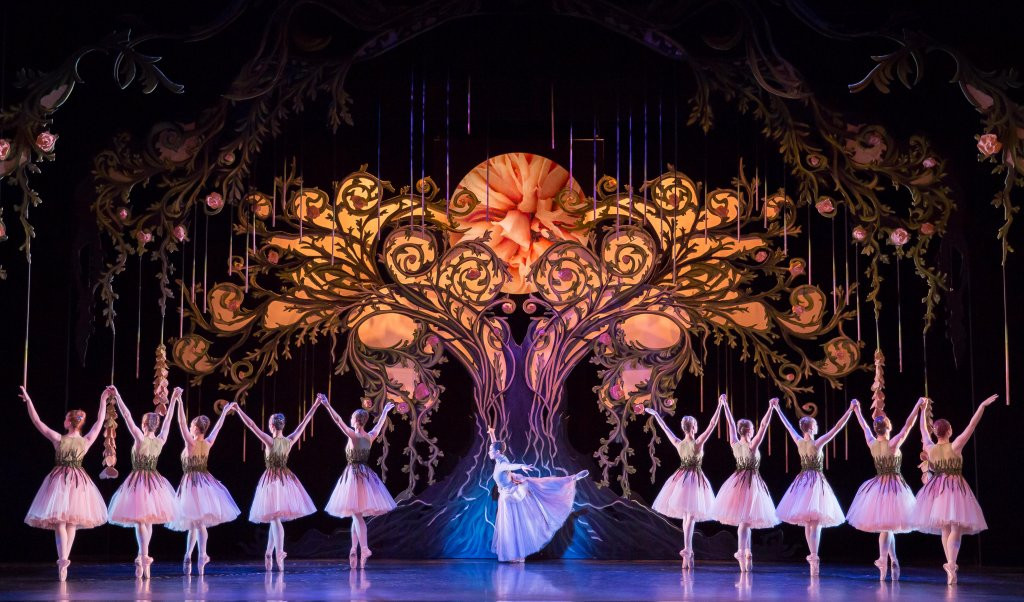 Scottish Ballet dancers perform on a professional sprung vinyl dance floor from Harlequin Floors
Scottish Ballet dancers perform on a professional sprung vinyl dance floor from Harlequin Floors
Scottish Ballet showcasing a performance on Harlequin Cascade dance floor.
2. Ballroom: Partnered Elegance and Rhythmic Precision
Originating in France in the late 16th century, ballroom dance is a social partner dance that has evolved into a captivating performance and competitive genre. Often used as an umbrella term for partner dances, ballroom is broadly categorized into two main styles: Standard (or Smooth) and Latin (or Rhythm).
Standard ballroom dances like the Waltz, Tango, and Foxtrot are characterized by elegant, flowing movements and close partner connection. Latin dances, such as Paso Doble, Bolero, and Samba, are more energetic and sensual, featuring vibrant rhythms and dynamic hip movements. Ballroom dancing is a popular competitive dance form, known as dancesport, with competitions held globally. The versatility required by ballroom dancers necessitates specialized dance floors like Harlequin Fiesta and Harlequin Liberty Ballroom, designed to accommodate the diverse movement demands of these styles.
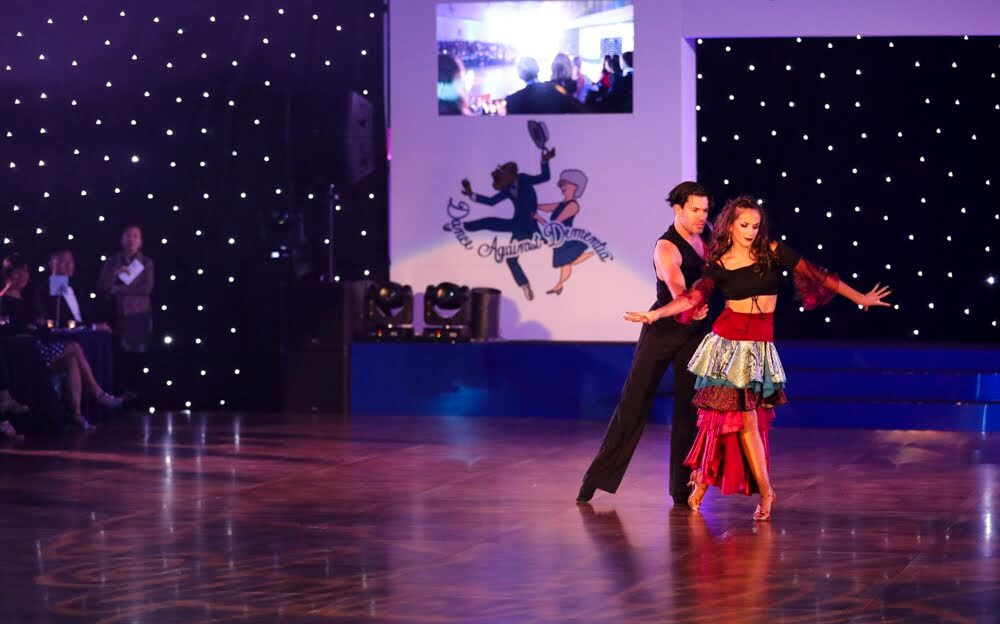 Ballroom dancers in action at a Dance Against Dementia event, performing on Harlequin Liberty Ballroom floor
Ballroom dancers in action at a Dance Against Dementia event, performing on Harlequin Liberty Ballroom floor
Elegant ballroom dancers at “Dance Against Dementia” event on Harlequin Liberty Ballroom.
3. Contemporary: Expressive Freedom and Fluidity
Contemporary dance emerged in the mid-20th century as a departure from the strictures of classical ballet and modern dance. It prioritizes emotional expression, versatility, and innovation, drawing inspiration from various dance styles including classical ballet, modern, and jazz. Contemporary dance is characterized by its emphasis on floor work, fall and recovery, contract and release techniques, and unpredictable changes in rhythm and dynamics.
Known for its freedom of movement and exploration of space, contemporary dance allows dancers to connect with their emotions and tell stories through movement. The physical demands of contemporary dance, with its rapid transitions and dynamic movements, necessitate shock-absorbing dance surfaces like Harlequin Activity sprung floors, often paired with vinyl surfaces, to protect dancers from injury.
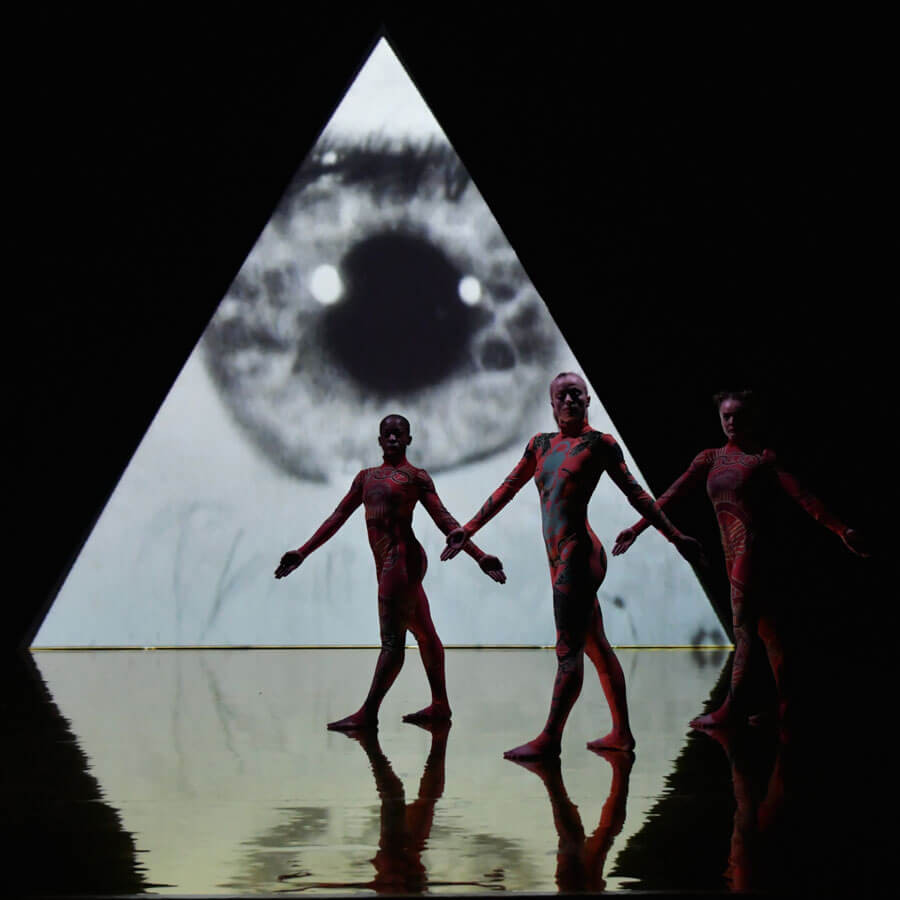 Contemporary dancer Rosie Kay performing on Harlequin Hi-Shine vinyl dance floor
Contemporary dancer Rosie Kay performing on Harlequin Hi-Shine vinyl dance floor
Contemporary dance artist Rosie Kay performing on Harlequin Hi-Shine floor.
4. Hip Hop: Urban Rhythms and Street Style
Hip hop dance originated in the early 1970s in New York City and California, emerging from street culture and evolving alongside hip hop music. It’s a broad and dynamic category encompassing various street dance styles like Breaking (breakdancing), Locking, and Popping. Derivative styles, such as Memphis Jookin’, Turfing, Jerkin’, and Krumping, have further expanded the hip hop dance landscape.
Characterized by its improvisational nature, rhythmic complexity, and energetic movements, hip hop dance is often performed in cyphers, battles, and on stages worldwide. It’s deeply rooted in community and self-expression. The dynamic and grounded movements of hip hop require specialized dance floors like Harlequin Freestyle, designed to provide the right balance of grip and slip for street dance styles.
 Hip hop dance crew Da Rookies performing on Harlequin FreeStyle dance floor
Hip hop dance crew Da Rookies performing on Harlequin FreeStyle dance floor
Hip hop dance group Da Rookies in performance on Harlequin FreeStyle floor.
5. Jazz: Syncopated Rhythms and Energetic Expression
Jazz dance has its origins in African traditions brought to the Americas during the transatlantic slave trade in the 17th century. It developed in the early 20th century, emerging from African American vernacular dance forms and social dances popular in jazz clubs. Jazz dance is known for its improvisational nature, syncopated rhythms, isolations, and dynamic, expressive movements.
Styles like Swing, Lindy Hop, Shimmy, and Charleston are all variations of jazz dance. Today, jazz dance is a vibrant and diverse genre, performed both socially and on stage, often incorporating elements of ballet, modern, and tap. For jazz dancers, vinyl dance floors like Harlequin Studio and Harlequin Allegro provide ideal surfaces for both practice and performance, offering the right amount of slip and grip for a variety of jazz styles.
 Group of jazz dancers performing energetic movements on a dance floor
Group of jazz dancers performing energetic movements on a dance floor
Dynamic jazz dance performance with jumping and expressive movements.
6. Tap Dance: Rhythmic Footwork and Percussive Sounds
Tap dance is a percussive dance form characterized by rhythmic sounds created by metal taps on the dancer’s shoes striking the floor. It evolved from a fusion of African rhythms and European clog dancing, becoming popular in vaudeville and musical theatre. Tap dance focuses on intricate footwork, clear rhythms, and often incorporates improvisation and complex choreography.
Variations include rhythm tap, classical tap, Broadway tap, and postmodern tap. The clarity of sound is crucial in tap dance, requiring specialized flooring that enhances the percussive quality. Harlequin Fiesta is a recommended tap dance flooring solution, especially when paired with a sprung floor like Harlequin Liberty, to provide both sound quality and dancer safety.
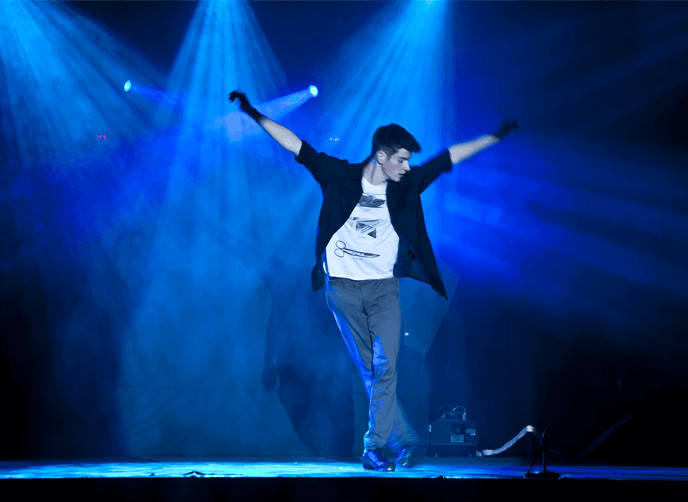 Tap Attack group performing synchronized tap dance choreography on Harlequin Cascade floor
Tap Attack group performing synchronized tap dance choreography on Harlequin Cascade floor
Tap Attack performing synchronized tap dance on Harlequin Cascade.
7. Folk Dance: Cultural Heritage and Community Celebration
Folk dances are traditional dances rooted in specific cultures and communities worldwide. They reflect the customs, values, and stories of a particular group of people. Folk dances are often participatory and social, performed at community events, festivals, and celebrations. They can express a wide range of emotions, historical narratives, and aspects of daily life.
Examples of folk dances include Bharatanatyam (India), Samba (Brazil), and Hula (Hawaii). Many cultures have diverse folk dance traditions, with variations for different occasions and social contexts. Portable performance floors and dance floor hire services from companies like Harlequin Floors are ideal for folk dance events in diverse venues, ensuring a safe and appropriate dance surface for community participation.
 Folk dancers in traditional attire performing a cultural dance
Folk dancers in traditional attire performing a cultural dance
Enthusiastic folk dancers in traditional dress performing a cultural dance.
8. Irish Dance: Energetic Footwork and Celtic Tradition
Irish dance is a traditional dance form originating from Ireland, characterized by its intricate footwork, upright posture, and energetic movements. Popularized globally by shows like Riverdance, Irish dance is known for its rapid leg movements, percussive steps, and formations. It’s deeply rooted in Irish culture and is often performed at festivals and competitions, accompanied by traditional Irish music.
Irish dance includes both solo and group forms, such as stepdance and céilí dance. Specialized Irish dance floors are important for providing the right surface for fast footwork and injury prevention. Harlequin Standfast vinyl floor, when used over a sprung floor, is a suitable option for Irish dance studios and performance spaces.
 Riverdance troupe performing their famous Irish dance choreography on Harlequin Cascade
Riverdance troupe performing their famous Irish dance choreography on Harlequin Cascade
Riverdance troupe showcasing energetic Irish dance on Harlequin Cascade.
9. Modern Dance: Individual Interpretation and Expressive Freedom
Modern dance developed in the late 19th and early 20th centuries in the West as a rebellion against the rigid rules of classical ballet. It emphasizes personal expression, freedom of movement, and the dancer’s interpretation of music and emotions. Modern dance rejects traditional ballet techniques, embracing natural and unconventional movements to convey meaning and tell stories.
It is characterized by its versatility and lack of codified technique, encouraging dancers to explore their own movement vocabulary. Printed vinyl performance floors from Harlequin Floors can enhance the creative expression in modern dance, allowing for customized stage designs. The adaptable nature of modern dance also makes many of Harlequin’s vinyl floors suitable for this genre.
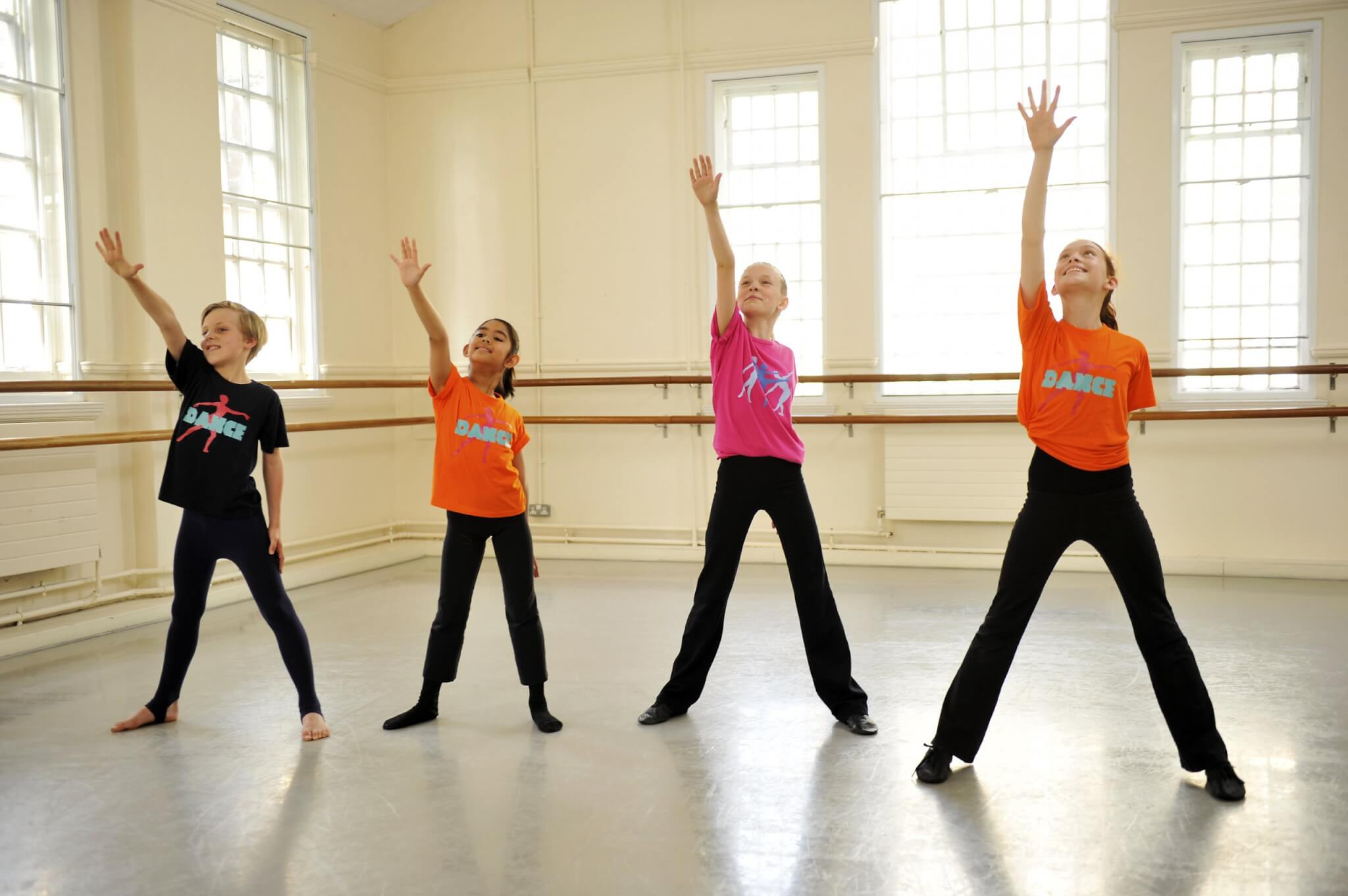 Dancers from the Royal Academy of Dance performing on Harlequin Cascade
Dancers from the Royal Academy of Dance performing on Harlequin Cascade
Royal Academy of Dance students in a modern dance performance on Harlequin Cascade.
10. Swing Dance: Joyful Partnering and Rhythmic Swing
Swing dance emerged in the 1920s to 1940s in America, evolving alongside swing jazz music. It’s a lively and social partner dance characterized by its upbeat rhythms, playful movements, and improvisational nature. Popular swing dance styles include Lindy Hop, Charleston, Jitterbug, and Balboa.
Swing dance is known for its energy, connection between partners, and joyful spirit. It’s often performed to big band swing music and is enjoyed socially and competitively. Vinyl dance floors like Harlequin Reversible Pro are well-suited for swing dance, offering a slip-resistant surface for dynamic movements and partner work.
Swing dancers demonstrating the lively movements of the style.
From home practice to professional studios, Harlequin Floors provides a wide range of products, including dance floors, barres, and installation services, catering to diverse dance styles and needs.
Contact Harlequin Floors for expert advice on choosing the perfect dance floor for your style.
